Noel Kempff Mercado National Park, Bolivia
| Topics: |
Contents
- 1 Geographical location
- 2 Date and history of establishment
- 3 Area
- 4 Land tenure
- 5 Altitude
- 6 Physical features
- 7 Climate
- 8 Vegetation
- 9 Fauna
- 10 Cultural heritage
- 11 Local human population
- 12 Visitors and visitor facilities
- 13 Scientific research and facilities
- 14 Conservation value
- 15 Conservation management
- 16 IUCN management category
- 17 Further reading
Geographical location
Noel Kempff Mercado National Park (NKMNP) (13°31’-15°05’S and 60°14’-61°49’W) is a World Heritage Site located in the north-eastern portion of the Santa Cruz Department, on the border with Brazil. Its limits are determined mostly by rivers, where they are defined by international landmarks shared with Brazil. NKMNP belongs to Amazonian biogeographical province.
Date and history of establishment
- 1979: NKMNP established under the name of Huanchaca National Park, according to Supreme Decree 16,646 of 28 June 1979.
- 1988: park name changed to the actual one by Law 978 of 4 March 1988; the park boundaries corrected and broadened by Supreme Decree 21,997 of 31 August 1988.
- 1996: park area extended by Supreme Decree 24,457 of 23 December 1996.
Area
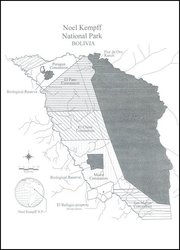 Map of the Noel Kempff National Park. (Source: Noel Kempff National Park)
Map of the Noel Kempff National Park. (Source: Noel Kempff National Park) NKMNP encompasses a total area of 1,523,446 hectares (ha). The park does not have a legally defined buffer zone, although this has been recently proposed and when agreed it will cover 366,000ha.
Land tenure
The park is almost totally publicly owned. One large ranch overlaps the core zone in about 25,000 ha. There are several other pending land claims but there is confidence that they will be resolved in the park's favor.
Altitude
NKMNP ranges in altitude from 200 meters (m) to 750m at the top of the Huanchaca Plateau.
Physical features
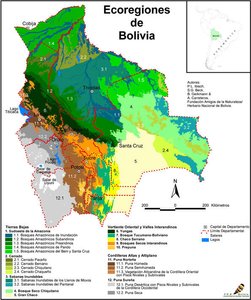 Ecoregions of Bolivia. (Source: Noel Kempff National Park)
Ecoregions of Bolivia. (Source: Noel Kempff National Park) NKMNP includes a large section of the Huanchaca Plateau and surrrounding lowlands. The plateau is 150 kilometers (km) long and 50km wide, and covers a total area of 6,800 square kilometers (km2), of which 5,300km2 are in Bolivian territory. It is composed of sandstone and quartzite (Metamorphic rock) rocks of Pre-Cambrian origin, deposited more than 1,000 million years ago. There are rugged cliffs in the northern, western and southern sides of the plateau, with several valleys and steep slopes in its eastern side. The largest river in the area is the Iténez which marks the border with Brazil, to the north of the park. It meets with the Mamoré River which, at the same time, meets with the Madera River, one of the main tributaries of the Amazon River. The park is part of the drainage system of the Iténez River Basin which includes the sub-basins of the Verde, Paucerna and Paraguá rivers. The Verde and Paucerna rivers have their origins on the plateau and their watercourses form beautiful falls such as the Fawcett, Federico Ahlfeld and Arco Iris. The Paraguá River dominates the lowlands to the west. This river flows into the Iténez and in the rainy season it overflows large extensions of flooded forests and savannah wetlands. To the west of the plateau, and in the lowlands, there are three great fields that become flooded at varying levels during the rainy season, and several lagoons of different size, the most important of which are La Bahía (12,5km2) and Bella Vista (20km2).
Climate
NKMNP has a seasonal tropical climate. The annual mean temperature ranges from 25 degrees Celsius (°C) to 26°C. November is the warmest month and June the coolest. The extreme temperature ranges from an average monthly maximum of 30°C and an average monthly minimum of 18°C. During June and July, temperature descends from south to north, due to the penetration of cold fronts, with a minimum of 3°C for several days in a row. The annual average rainfall ranges from 1,400 to 1,500 millimeters (mm).
Vegetation
The northeastern sector of the Santa Cruz Department, where NKMNP is located is part of a transition zone where Amazon forest intergrades with the dry forest and savannah habitats of the biogeographical province of the Cerrado. Habitat types of the region can be grouped into five basic units that represent distinct ecosystems: upland evergreen forest; deciduous forest; upland Cerrado savannah; savannah wetlands; and forest wetlands. Three of the major ecosystems found in the park (Cerrado savannahs, semideciduous forest and savannah wetlands) are globally threatened. In addition, two additional habitats (riverine forest and humid evergreen forest) are considered to be threatened on a regional scale. An estimated 4,000 vascular plantspecies occur in NKMNP, with 1,500 species in humid forests, 800 species in Cerrado habitats, 700 species in dry forests, 500 species in savannah wetland communities and another 500 species in aquatic habitats, disturbed places and rock outcrops.
The humid forests of the park are floristically distinct from the moist forests of western Amazon and the Andean piedmont. Humid high forest is the most species rich formation in the region, but levels of species diversity here are well below those for humid forest formations in other parts of the Neotropics. These forests are classified in several habitat types still scarcely studied. An evergreen forest with tall trees (45m in height) is found on deep and well-drained soils, while there is a dwarf forest formation occupying a transition zone between the previous type and the Cerrado. Another peculiar formation is constituted by the forest of lianas, characterised by a low and very thick canopy. Some emerging trees are present, but lianas proliferate in such a way that they dominate the canopy. A mixed forest of lianas is a transition zone between the semi-deciduous forests and the forests of lianas.
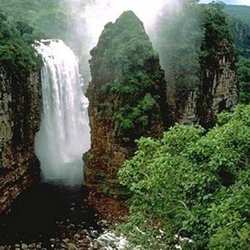 Arcoiris (Rainbow) Waterfall cascading off the Huanchaca Plateau along the Rio Pausema. (Source: Noel Kempff National Park)
Arcoiris (Rainbow) Waterfall cascading off the Huanchaca Plateau along the Rio Pausema. (Source: Noel Kempff National Park) The Huanchaca Plateau has a rich Cerrado flora that incorporates many species that were thought to have a distribution restricted to central Brazil. Huanchaca is physically separated from similar plateaus, to the north and east, by the wide valley of the Iténez River; this indicates that the Cerrado savannahs on the plateau have a long history of isolation that may well stretch back several millions of years The Cerrado covers around 272,000ha of the park. Dry forests exist as scattered pockets and cover only 11,651ha of the park. This formation, known in Bolivia as the Chiquitano Semideciduous Forest, is similar in composition and structure to the dry forests of the Misiones region of eastern Paraguay and northeastern Argentina, the Caatinga region of Brazil and the Andean piedmont in north-west Argentina. This is one of the most endangered ecosystems in the continent. Habitat loss due to agricultural development has occurred in the more densely settled regions where it once was the predominant vegetation type. Bolivia currently contains the largest portion of this dry forest formation and quite possibly the largest extant dry forest formation in the world.
A large part of the alluvial plains of the Paraguá and Itenéz rivers have extensive plains that are seasonally flooded. Different types of flooded savannahs and swamps dominate this landscape. The hydrological cycle constitutes the prevailing abiotic factor leading to the development of these savannahs, and even slight topographic changes may cause surprising changes in the structure and composition of the vegetation. Part of this flat areas are covered by thousands of termite mounds and receive the name of termite plains. The watery plains are flooded savannahs similar to the termite plains, but characterised by the absence of termite mounds and by the presence of scattered islands of forest. The savannah swamps are flooded habitats found mostly around perennial lagoons and in plains where the main courses disappear. A palm swamp often develops with a sparse arboreal layer and groups of palms of the species Mauritia flexuosa and Mauritiella aculeata. This important ecosystem reaches its largest extension in the influence areas associated to the Tarvo and Paraguá rivers.
Fauna
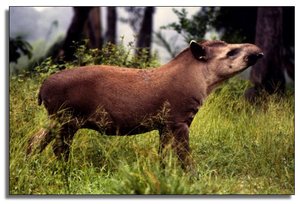 Tapir. (Source: Noel Kempff National Park)
Tapir. (Source: Noel Kempff National Park) The outstanding habitat diversity of NKMNP favours the existence of a highly diverse fauna, including 139 species of mammals, 620 [bird]]s, 74 reptiles, 62 amphibians and 254 fish. The large mammal fauna of the park is relatively well known; much less is known about its small mammal fauna, particularly of the bats. NKMNP is an important repository for many rare mammals of Bolivia, and is the only large protected area where some of these may occur. Over 80% of the mammal species of the park were recorded from humid forests. Good populations of tapir Tapirus terrestris (NT), brocket deer Mazama sp. and jaguar Pantera onca (NT) inhabit the upland humid forests. Long-haired spider monkey Ateles belzebuth (VU) has large populations throughout the tall evergreen forests, and black-tailed silvery marmoset Callithrix argentata and monk saki Pithecia monachus (DD) are also present. Three species of Pteronotus bats are found the in the park, being the only known location in Bolivia for this genus. Dry forests and woodlands, Cerrado and savannah habitats harbour less than half as many mammals as do the tall evergreen forests. Several very rare (or very poorly known) marsupials, such as Glironia venusta (VU) and Monodelphis kunsi (EN) were found in dry woodlands. The open grassland habitats on the southern portion of the plateau have possibly one of the largest remaining populations of pampas deer Ozotoceros bezoarticus (NT). Two other large mammals, maned wolf Chrysocyon brachyurus and marsh deer Blastocerus dichotomus (VU), are found in the seasonally flooded termite savannahs below the plateau. Other species, such as giant anteater Myrmecophaga tridactyla (EN) and giant armadillo Priodontes maximus (EN), are found both in humid forests and in the drier habitats, but appear to reach their greatest population densities in the termite plains. Along the Paucerna and Verde rivers, giant otter Pteronura brasiliensis (VU) and La Plata otter Lutra longicaudis are present, whereas Boto Inia geoffrensis (VU) is frequent in the Iténez River.
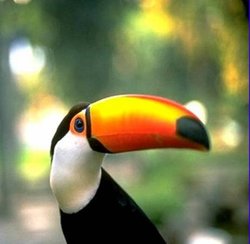 Toco toucan. (Source: Noel Kempff National Park)
Toco toucan. (Source: Noel Kempff National Park) The bird fauna of the park is relatively well known, having been surveyed to date at 14 different locations. Bird species diversity is highest in the humid forests and the park is very important for the conservation of Amazon species of conservation concern, such as red-throated piping-guan Aburria cujubi, Gould’s toucanet Selenidera gouldii, snowy-capped manakin Pipra nattereri and tooth-billed wren Odontorchilus cinereus, that are restricted to the Amazon region south of the Amazon River and east of the Madeira River. The park is also the only protected area within which is found the extremely range-restricted rusty-necked piculet Picumnus fuscus that is known only from seasonally flooded forests along the Iténez River. Despite its location at the periphery of the Cerrado region, the park is extremely important for the conservation of birds of Cerrado habitats. The park has populations of 20 open habitat bird species that are considered to be endangered, including hyacinth macaw Anodorhynchus hyacinthinus (VU), rufous-sided pygmy-tirant Euscarthmus rufomarginatus (VU), black-bellied seedeater Sporophila hypochroma (NT) and black-and-tawny seedeater Sporophila nigrorufa (EN).
The largest component (almost 50%) of the reptilian fauna consists mostly of Amazon species, with species from southern and eastern open formations comprising an additional 23% of the reptilian fauna. Several species enter Bolivia only in this area of the country. Preliminary data indicate that the most abundant reptile species are yellow-spotted river turtle Podocnemis unifilis (VU), caiman Caiman crocodilus and tegu lizard Tupinambis teguixin. Black caiman Melanosuchus niger (EN) and South American river turtle Podocnemis expansa (CD) are also present in the area. The most common amphibians in the park include Bufo typhonius, Hyla nana and Physalaemus albonotatus.
NKMNP rich fish fauna represents 60% of the Amazon species known from Bolivia. The park also is an important area for the protection of geographically restricted fish species. The Iténez River Basin is the only major river system in Bolivia that originates on the Brazilian Shield, causing it to be dramatically different from other rivers of eastern Bolivia in the physical and chemical characteristics of its waters. These features have caused that some 65 species of the Iténez Basin (26% of the total number recorded from it) either are endemic or have relatively restricted distributions. Several of these species are restricted to black water systems and have a peripheral distribution in the northern and eastern edges of Bolivia. Among the most outstanding of these species are Helogenes marmoratus, Carnegiella strigata, Hypopygus lepturus, several species of the genus Hyphessobrycon, Bryconops melanurus, Bryconops sp., Jobertina lateralis, Poecilobrycon harrisoni and Acanthodoras spinosissimus.
The high overall diversity (Species diversity) reflects the variety of aquatic systems in the park, ranging from small clear water streams to large black water lakes and rivers. The extensive floodplains covered with both savannah and forest formations offer many specialised habitats and abundant food resources to sustain fish populations. The Huanchaca Plateau remains largely unexplored by ichthyologists and it can be expected that several new species will be found there.
NKMNP contains a large diversity of insects. The dung scarab beetle fauna in the park and adjacent regions, totalling 97 species, is the most diverse yet recorded in the Neotropics for a restricted area of this size. This unexpected species richness largely seems to be the result of the high habitat heterogeneity of the park and a high rate of species turnover between habitats. The habitat with the greatest species richness was the humid forest at Los Fierros, with 64 species and a scarab beetle community that is typical for a moist lowland Amazonian site.
Cultural heritage
Among one of the first records of the area covered by NKMNP and its surroundings is the description of the Huanchaca Plateau made by Percy Fawcett in 1910. Fawcett’s writing about his expedition was so motivating that Sir Arthur Conan Doyle based his novel The Lost World on the region. The name given to the former Huanchaca National Park was given as a posthumous homage to the scientific activities developed by Professor Noel Kempff Mercado who was murdered by drug dealers in the Huanchaca cliffs on 6 September 1986, together with three other companions, during an expedition to the plateau and to the Paucerna River waterfalls.
Local human population
Less than 30 people live within the borders of NKMNP and the park is relatively closed to a series of communities which settled in the area since approximately the end of the XIX Century. The most important populated centers are: Florida, Hacienda Chirapas, El Porvenir, Piso Firme and Remanso. There are other small riverside populations along the Itenéz River, such as Bella Vista, San Francisco and Esperancita de la Frontera, on the southern border. NKMNP generates natural resources that allow the subsistence of the human populations living in the periphery. These populations hunt wildlife, extract fibers, medicinal plants and building materials. The potential of commercialization of some of these resources is both significant and promissory, particularly for caimans, turtle eggs, snails, fish, ornamental plants, bush meat, skins and wood.
Visitors and visitor facilities
Access to the NKMNP is possible following two routes: from the north to Piso Firme and from there fist through the Paraguá River and then passing the Itenéz River, until arriving to the camps of Bella Vista, El Milagro, Tacuaral, Boca del Paucerna, Flor de Oro, Las Torres, Mangabalito and Boca del Verde. From the south-west, access to the park is possible from Florida and the facilities of Moira sawmill to Campamento Los Fierros. From here, and towards the north, the main timber road connects to Bella Vista Lagoon. The park can also be accessed going south the borderline with Brazil, through an area known as Marco Falso. Another option for the transport of passengers is by air. Many of the communities located in the vicinity of the park, such as Florida, Porvenir, Piso Firme and Remanso have landing strips. The park has also landing strips in the area of Los Fierros, Flor de Oro, Mangabalito, Las Gamas and Huanchaca I. The average travel time from Santa Cruz de la Sierra and Flor de Oro is 2.5 hours.
Approximately 800 tourists have visited the park in the last five years through the Fiends of Nature Foundation (FAN) and the park itself. Visitors have stayed mainly at the facilities of Flor de Oro with lodging capacity for up to 35 people in double occupancy cabins (each with private bathrooms), solar generated electricity (110 and 220 volts), a large kitchen/dining area, an observation tower and a large interpretation center that will be finished soon. There is another comfortable, albeit rustic lodge in Los Fierros with capacity for up to 25 people, running water, a large kitchen/dining area and over 40 kilometers of well developed trails including a self-guided interpretive trail. The only community which has facilities for visitors is Piso Firme. There is one hotel in this locality that is quite rudimentary although it was built with the typical local architecture. It has four rooms with capacity for 16-20 people and a small restaurant. The park has recently become an annual stop for several tour companies that specialise in bird watching groups.
In 1920, the town of Perseverancia sprung up west of the park in the heart of Bolivia's wilderness. The rubber boom was in full swing, and the town was the centre of production for several years before the market fell, causing most of the rubber tappers to leave. In 1972, the last two remaining tappers moved on. About the same time, an airstrip was constructed, and the settlement became a centre for the illegal trade in animal skins. Professional hunters collected hundreds of otters, jaguar and other skins until 1986 when the area was abandoned. In 1989, a tourist facility was built for those wishing to experience nature in its purest form. It is only accessible by private aircraft and the setting is unparalleled in terms of isolation.
Scientific research and facilities
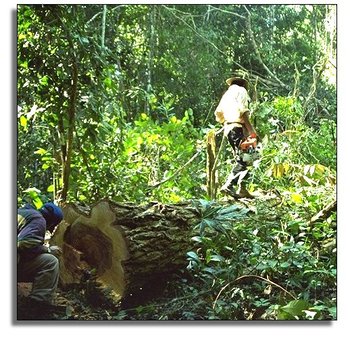 Accurately measuring and reporting the level of carbon dioxide captured as a result of the project is one of its most important components. Using thorough field procedures at 625 permanently established carbon plots in the Park, and about 100 permanent plots in nearby active forest concessions to measure real logging impacts and an advanced dual camera aerial videography technology developed at the University of Massachusetts, the monitoring and verification program will quantify with a high degree of precision how much carbon existed in the project area prior to commencement of the project, the carbon losses avoided, and how much carbon is captured as a result of the project. (Source: Noel Kempff National Park)
Accurately measuring and reporting the level of carbon dioxide captured as a result of the project is one of its most important components. Using thorough field procedures at 625 permanently established carbon plots in the Park, and about 100 permanent plots in nearby active forest concessions to measure real logging impacts and an advanced dual camera aerial videography technology developed at the University of Massachusetts, the monitoring and verification program will quantify with a high degree of precision how much carbon existed in the project area prior to commencement of the project, the carbon losses avoided, and how much carbon is captured as a result of the project. (Source: Noel Kempff National Park) Field research has been intense in the park. Some of this research has been focused on questions related to the dynamics of the forest-savannah boundary and its relationship to climate change. Forest islands may be remnants of a previously more widespread forest or they could be true forest islands that have become established via seed dispersal to appropriate sites. The floristic composition of forest islands is being compared to the nearby continuous forest. Plant species are classified according to dispersal strategies, and the abundance of different dispersal strategies is related to island size, distance between islands, and the relationship of the forest islands to the landscape. A multidisciplinary approach is being used, and scientists from a variety of institutions coordinate their own investigations with the ongoing botanical research in the park. The plots and study grids that are being established in the park by Garden botanists and their Bolivian colleagues provide these scientists with a framework around which they can address their research questions related to forest fragmentation, climate change, fire, and landscape ecology.
Conservation value
NKMNP hosts one of the largest undisturbed wilderness areas in the Neotropics. Amazon rainforest, Cerrado habitat, pampas and gallery forests provide a wide range of habitats. With its rainforests, clear-water rivers, striking waterfalls, vast, forested plateau and rugged escarpments, the park includes the most dramatic scenery in northeastern Bolivia. The park is matched in size and extraordinary landscape only by its incredible diversity of flora and fauna. Many plant species have yet to be identified or receive a name. In particular, the park holds perhaps the largest piece of virgin Cerrado habitat left on Earth. More typical of central Brazil, most of that has been turned into soybean production. Many rare and endangered animals are found here, including maned wolf, giant anteater, giant armadillo, and pampas and marsh deers.
Conservation management
NKMNP is under the co-management of the National Protected Areas System (SERNAP) and Fundación Amigos de la Naturaleza (FAN). This system is permitted by the General Law of the Environment (Law No. 1,331 of 1991), and has been agreed between the Ministry of Sustainable Development and Environment (MDSMA), SERNAP and FAN, by means of a ten-year contract. Through this agreement, obligations and rights were transferred from the State to FAN along with funds coming from the International Bank of Reconstruction and Development (BIRF), through the donation agreement GETF No. 28,620-BO. FAN activities are ruled by the guidelines prepared by SERNAP; this non-governmental organization (NGO) is responsible for implementing the management actions of the park, its surveillance and the administration of funds.
In 1996, FAN elaborated the long-term management plan of NKMNP in collaboration with the Nature Conservancy (TNC). This document recommends management measures such as the increase in the number of rangers; the demarcation of the Park; the eradication of livestock from the area of Estancia Flor de Oro; the design and implementation of a monitoring program; and the development of a general training program for the personnel in charge of eco-tourism activities. While it is correct to say the park does not have a decreed buffer zone, much of the west flank is included in the Alto Paragua Forest Reserve, almost all of which is in the process of being legally titled to three communities located to the west of the park. On the Brazilian side of the border there are several smaller state protected areas in Mato Grosso and Rondonia, and Brazilian and Bolivian authorities have been meeting to propose a major, 10 million hectare biological corridor north from the park along the Itenez River.
SERNAP has demanded that, in order to facilitate its administration and management, the structure of the park should consists of the following three committees: (a) the Administration Committee, which is in charge of supporting the park’s director, and will be constituted by the director himself, a representative of each of the neighbouring communities, a representative of the Municipality of San Ignacio, a member of SERNAP, a representative of the Prefecture of the Department of Santa Cruz and a member of FAN; (b) the Scientific Advisory Committee, which is integrated by no more than five members of re-known trajectory in the scientific field; and (c) the Local Eco-tourism Council, which is integrated by a representative of each of the following institutions: SERNAP, FAN, the Tourism Directorate of the Department of Santa Cruz, the Prefecture of Santa Cruz, the Municipality of San Ignacio and the Base of Territorial Organisations of the five local communities.
Also in 1996, the Bolivian government signed an agreement with TNC, three major U.S. corporations and FAN to begin a forest conservation project in NKMNP designed to help reduce global greenhouse gas emissions, under the 1992 United Nations Framework Convention on Climate Change. As part of the project, the Bolivian government added almost 345,000 ha of forestland to the park. By investing in the protection of this area, the three corporations and the Bolivian government will receive carbon offset credits. The Noel Kempff Climate Action Project includes activities that will ensure park protection for 30 years by fostering sustainable micro-enterprise development and establishing a long-term endowment fund for the park. The project also will provide important environmental and socio-economic co-benefits to Bolivia, including biodiversity conservation, sustainable economic development for local communities and protection of precious soil and water resources.
Management constraints
According to the recently prepared Management Plan, the extraction of eggs of river turtles from the beaches of the Iténez River is a cause of major concern. River turtles are also subject to hunting along the same river. Populations of maned wolf, pampas deer and marsh deer, are potentially vulnerable to diseases borne by domesticated animals (dogs and cattle). To the greatest extent possible, this potential threat should be minimized by removing from the park all domestic or feral stock. The removal of these animals would have the added benefit of improving the natural experience of visiting tourists. One possible exception may be the use of horses or mules as pack animals to facilitate back country expeditions; however, this should be carefully evaluated to weigh the risk of disease transmission to native mammals.
Drug trafficking activities are a threat, especially in the area bordering with Brazil and the road of access to Piso Firme. They do not threaten any specific ecological element, but rather the security and authority of park’s staff. To mitigate this problem, efforts are being coordinated by the Military Police, the Bolivian Army, SERNAP and FAN.
During the dry season, there is risk of fires, coupled with the difficulty in early detection and the logistical constraints to fighting them. Also, commercial fishing by Brazilians occurs along the Itenez River and occasionally, illegally, into smaller tributaries and bays on the Bolivian side of the border. Bank erosion along the Itenez River also is a latent threat to the new infrastructure built at the Flor de Oro camp very near the river's edge.
Staff
NKMNP currently has approximately 45 employees, deployed in approximately one dozen permanent and temporary ranger stations and administrative posts ringing the park. Additional administrative support is provided by staff of FAN at its headquarters in Santa Cruz. The largest percentage of the staff are assigned to the protection program, with a staff of 25 rangers and chief rangers. Staff stability is high and FAN and SERNAP are providing personnel the opportunity to take part in training courses.
Budget
Between 1991 and 1994, the Parks in Peril Programme carried out by TNC and the United States Agency for International Development(US-AID) invested, through FAN, a total US$552,244 in actions to support park’s management. From 1994 to 1998, the programme’s contribution reached US$360,895. In 1993, the Swiss Technical Cooperation (COTESU) gave US$800,000 to FAN to implement a project to develop and implement the programme of eco-tourism for the park. In April 1995, a joint venture between FAN and TNC won the tender to prepare the management plan for the park, and received US$105,872 from the Bolivian National Environmental Fund (FONAMA). In May 1995, the ten-year agreement for the management of the park was signed by MDSMA, SNRMA and FAN, with funds provided by the GTEF, the PCBB and Debt for Nature Swap Programme/JP Morgan .
The operating budget for park management for the 2000 fiscal year is approximately US$700,000. This includes contributions of the Bolivian government for basic operating costs of over $100,000, plus investment earnings on the $1.5 million endowment, user fees, and most importantly, contributions as part of the $9.5 million Climate Action Project, a joint effort of the Bolivian government, the three U.S. power companies, and TNC. Direct support for park management under the Climate Action Project is scheduled to end in several years, and the Bolivian government is already actively searching for new funding sources and ways to bolster the endowment. The large size and remoteness and logistical difficulties contribute to very high fixed costs. The Climate Action Project has sponsored creation of a bioprospecting and natural projects company to identify and market biodiversity-based products that, it is hoped, will generate revenue for the park in the future. The lack of high tourism potential, and the fact that the park is not a source of water for urban, industrial, or hydropower uses means that innovative funding sources and mechanisms such as carbon projects will be extremely important to guarantee financial viability of the protected area in the long run.
IUCN management category
- Noel Kempff Mercado National Park II (National Park)
- Natural World Heritage Site - Criteria i, ii, iii, iv
Further reading
- IUCN (1996). 1996 IUCN Red List of Threatened Animals. IUCN, Gland, Switzerland. 368 pp. + Annexes. ISBN: 2831703352.
- Killen, T.J. and Schulenberg, T.S. (1998). A biological assessment of Parque Nacional Noel Kempff Mercado, Bolivia. Conservation International Rapid Assessment Papers Working Papers 10. ISBN: 188117350X.
- Parker, T.A., Gentry, A.H., Foster, R.B., Emmons, L.H. and Remsen Jr., J.V. (1993). The lowland dry forests of Santa Cruz, Bolivia: a global conservation priority. Conservation International, Rapid Assessment Program Working Paper 4. ISBN: 188117302X.
- Torres, H., Moreno, A. and Justiniano, H. (1999). Nomination of Noel Kempff Mercado National Park by the Republic of Bolivia for inclusion in the World Heritage List of Natural Sites. National Protected Areas System of Bolivia. 30 pp. + Annexes.
| Disclaimer: This article is taken wholly from, or contains information that was originally published by, the United Nations Environment Programme-World Conservation Monitoring Centre (UNEP-WCMC). Topic editors and authors for the Encyclopedia of Earth may have edited its content or added new information. The use of information from the United Nations Environment Programme-World Conservation Monitoring Centre (UNEP-WCMC) should not be construed as support for or endorsement by that organization for any new information added by EoE personnel, or for any editing of the original content. |